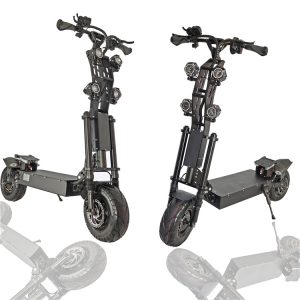Electric scooters, known as “scooters,” have become increasingly popular in recent years as a means of transportation in many cities around the world. They are convenient because they are easy to ride and can be quickly deployed in traffic. However, the widespread use of scooters has also raised concerns about their sustainability, particularly regarding energy consumption and environmental impact.
In this article, we will explore the sustainability of electric scooters and the various factors that contribute to their environmental footprint. We will also discuss potential solutions to these issues and what role individuals, governments, and companies can play in ensuring the sustainability of scooters.
First, let’s consider the energy source of electric scooters. Most electric scooters are powered by rechargeable batteries, which are typically recharged using electricity from the grid. While this sources of energy is generally clean, the overall environmental impact depends on how the electricity is generated. If the electricity comes from renewable sources, such as solar or wind power, then the environmental impact of using scooters is reduced. However, if the electricity comes from fossil fuels, then the environmental impact is significantly higher.
The second factor that contributes to the environmental impact of electric scooters is their production and disposal. The production of electric scooters requires raw materials such as metal, plastic, and battery components, which are typically extracted from the earth and processed through various manufacturing processes. This process can generate greenhouse gas emissions and other pollutants, contributing to the carbon footprint of scooters.
Another consideration is the disposal of electric scooters at the end of their life. Electric scooters are often designed to be durable and long-lasting, but they still reach the end of their useful life and need to be recycled or discarded. If electric scooters are not recycled properly, they can contribute to landfills and other forms of waste accumulation, leading to environmental degradation.
Despite these challenges, there are several ways that the sustainability of electric scooters can be improved. One approach is to promote the use of renewable energy to charge electric scooters. This can be achieved through the installation of charging stations that use solar or wind power, or by encouraging the use of electric scooters that have been charged using renewable energy sources.
Another way to improve sustainability is to improve the manufacturing process of electric scooters to reduce waste and emissions. This can be done by using more efficient manufacturing techniques, such as 3D printing, and by designing products that are easier to recycle and reuse.
Finally, individuals and governments can play a role in promoting the sustainability of electric scooters. can choose to ride electric scooters that are made from sustainable and support companies that prioritize sustainability. Governments can invest in and development projects in underprivileged areas to encourage the use of scooters and other forms of sustainable transportation.
In conclusion while electric scooters offer a convenient and eco-friendly mode of, it is important to recognize that they also have an environmental impact. By promoting the use of renewable energy, improving manufacturing processes, and encouraging individual and government responsibility, we can work towards a more sustainable future with electric scooters.




